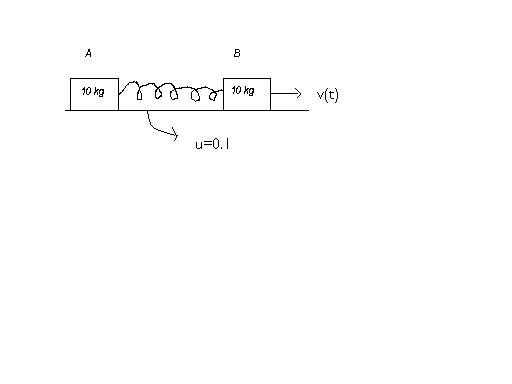In the diag uve shown that B is pulled with vel v(t) while in the ques, uve mentioned it is done with A.. clarify this
Two blocks A and B are kept on a rough surface of coefficient of friction u=0.1 . Block B is pulled with a constant time varying velocity v(t)=0.1t . Spring constant is k=100 N/m.Then answer the following :
1. Work done by spring force on Block A till t=1 sec
2. Work done by spring force on Block B till t=1 sec
3. Work done by friction on Block A till t=1 sec
4. Work done by friction on Block B till t=1 sec
-
UP 0 DOWN 0 0 8

8 Answers
uve to assume that the spring is initially at natural length and it is pulled with v(t)
havent given it much thought though
@ karna wat about the kinetic energies of d blocks ?? actually i solved it ..but waiting for oders
y is it zero?? and if the KE of oder is wat u said ....wy u didnt include it in ur equation above??
suppose x is the extension of spring
for A to move ...kx > uN
i.e x > uN/k i.e x > 0.1 x 100/100
x > 0.1 .........(1)
now at any time sb -sa =x...(2) where s = displacement
sb = ∫vbt = 0.1t2/2 = t2/20
at t =1 sec ....
sb = 0.05 ....(3)
frm (1),(2),(3)
0.05 - sa = x ........... (3)
now sa cannot be negative ..so max value of x in 1st sec =
0.05 ..wich is less dan 0.1 ..so A doesnt move ..so sa = 0
so x = sb = 0.05 m
so work done by spring on B
= - 1/2 kx2
= - 100 x 0.05 x 0.05/2
= - 0.125 J [ -ve bcz spring force and dsiplacment are in opp direction]
work done by friction = f.sb = - 0.1 x 100 x 0.05 =- 0.5 J
since displacement of A = 0 , work done by spring and friction on A= 0
more elaborated ..LOLZ by the way karna ...work ka unit Newton kabh se hua ?? lol